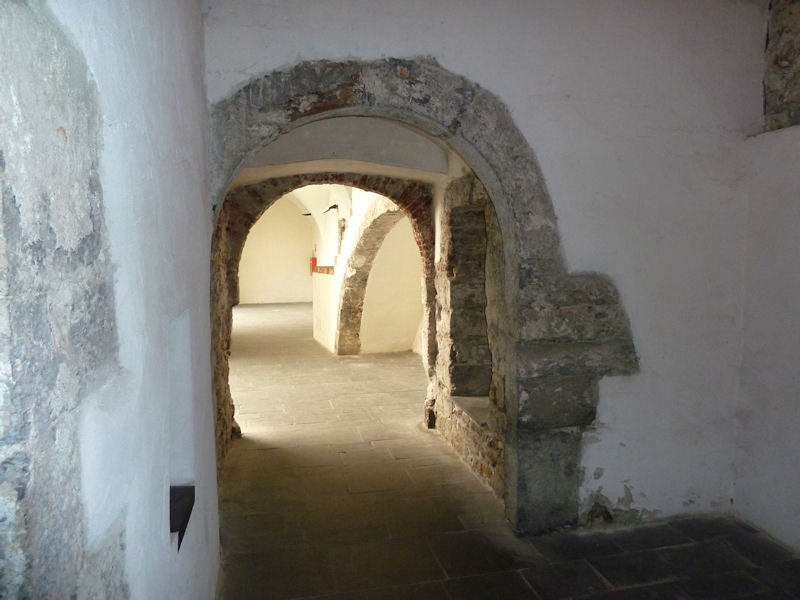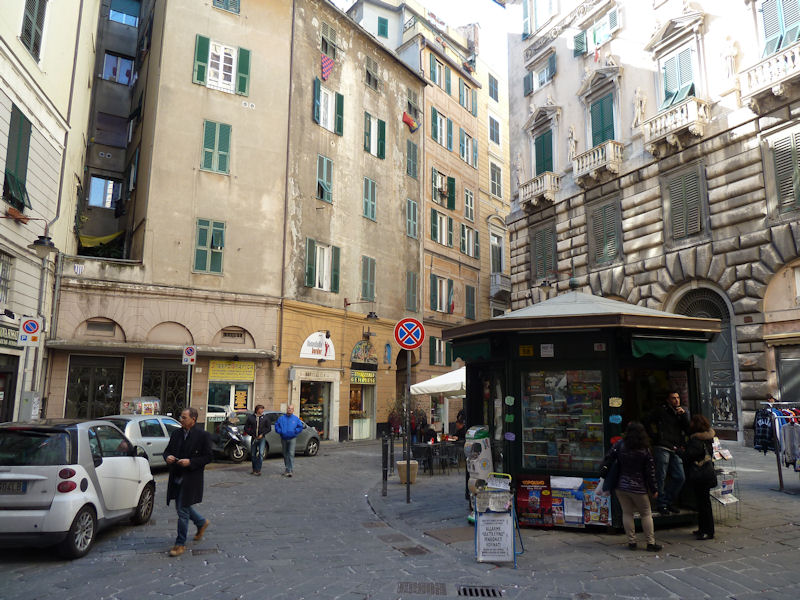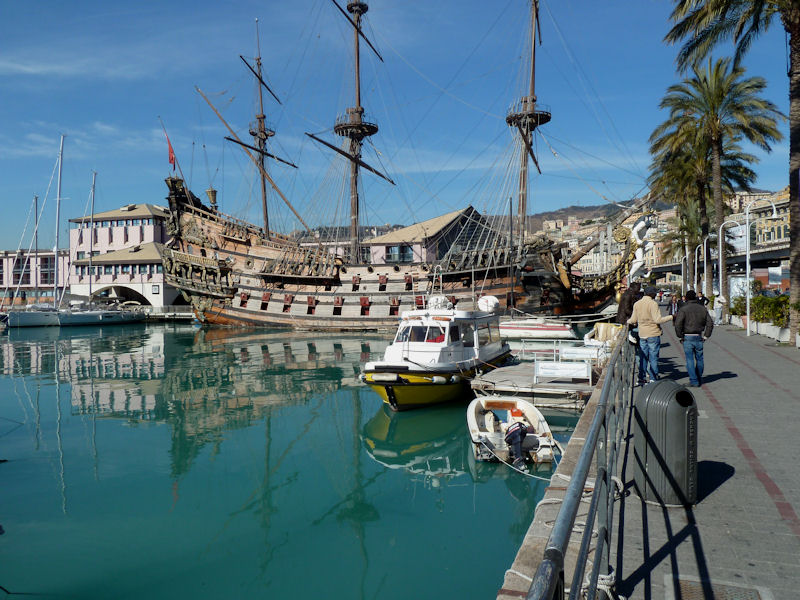|
 Dwight Peck's personal website Dwight Peck's personal website
Genoa, Italy, in 2012
A restorative February interlude (2)
We've shaken off the brutal European Cold Wave of early February 2012 and decided to recuperate on the south side of the Alps.
You may not find this terribly rewarding unless you're included here, so this is a good time for casual and random browsers to turn back before they get too caught up in the sweep and majesty of the proceedings and can't let go.
   

Six hours on the inexpensive train under the Simplon Pass via Domodossola and Milan, and we've fetched up at the Grand Hotel Savoia just outside the rail station Genoa Piazza Principe.

The Grand Hotel Savoia is a five-star hotel (I think that's a first for me). We even had carabinieri and soldiers with machine guns outside for a few days because, they said, of the "vip".

It certainly seemed sufficiently five-star to me, services, comforts, complimentary sweets, instant coffee sticks, bath gel and all that, but in February they charged us for the week what they normally charge (according to the rates list) for the night. The breakfast was enough to live on for a couple of days and by itself worth coming to Genoa for.

We're out for a good walk round to see what's what, and this is the San Giovanni upper church just down the street from the hotel. It's got a main door right through the apse (far right), because they had to make way for the San Giovanni lower church.

The lower San Giovanni is built back of this, a 13th century Knights Hospitaller of St John hospital and pilgrim hostel with a very interesting museumification of the insides of it.

The Commenda di San Giovanni di Pré, the Hospitallers' digs: exhausted travelers on the pilgrimage route to Rome, and perhaps to Brindisi and the Holy Land, got the enormous downstairs hall, plague-stricken lice-infested lepers in the upstairs hall -- and presently some very interesting medieval-invoking displays.

The topmost floor overlooking the port displays beautiful ceilings, good frescoes, and . . .

. . . an Italian bicycling museum.

Medieval doorways

The Via di Pré, one street above the port between the Commenda di San Giovanni di Pré and this city gate at Via delle Fontane, is pretty much a North African and Sub-Saharan ghetto, lively and crowded -- through the gate, above, are the Via del Campo and Via San Luca shopping streets.

Piazza Fossatello, one street up from the Porto Antico, with one of the ubiquitous kiosks

Piazza Fossatello and a ubiquitous kiosk in the old town

The old town is built round the Porto Antico (and the slightly less antico Porto Vecchio) on a fairly low-lying coastal fan surrounded by steep hillsides.

The Piazza dei Banchi (the medieval bankers changed money and foreclosed mortgages here, in the days before Occupy Wall Street) -- the commercial centre of the city until the 19th century. That's the Loggia dei Mercanti from the 16th century.

Kristin surveying the Piazza Caricamiento facing the port

Behold! Under the Sopraelevata Aldo Moro, the elevated highway -- it's a wonderful Dotto Train.

In fact, it's Dotto model Muson River Euro 5, pausing to load up with eager tourists before pushing off for a rewarding journey past all the most scenic spots. Clang clang.

Genoa's old port comes complete with a pirate ship.

A very authentic-seeming pirate ship, which can now be visited and walked round in.

The Neptune was built for Roman Polanski's film Pirates (1986) in El Kantaoui, Tunisia, where the movie was shot, and it fetched up here.

Some of the waterfront

This is the far side of the Bacino Porto Vecchio with the Mediterranean ferries lined up and the tower of the Lantern looming, the 14th century lighthouse whose keeper in 1449 is said to have been Christopher Columbus' uncle Tony.

Here's the central city park, rafts stuck far out into the harbor on tethered barges.

Fancy Pants. The Shubra II, a 60-metre aluminum yacht built in the US in 1998, whose home port, coincidentally, is Sturgeon Bay, Wisconsin.
Behind it, the Darth Vader of yachts . . .

A sleek, futuristic, and ominously black yacht that looks as malevolent as the "Black Fortress" US embassy in Ottawa.

It's the Sea Force One, a 54-metre superluxury yacht built and based here in Genoa, what a spectacle.

We tried to get a little closer to Sea Force One (to see if there were any Special Ops commandos on board, or just luxury yacht guys), but that pier is padlocked and guarded, so here's a Lumix-zoom of the stern of it. Nice drapes.

And this is an old freighter permanently moored here, as another sort of city park for sunbathing, restaurants, and what not, just beyond the famous Genoa Aquarium in the background (too expensive for us).

Wharves full of nice-looking apartments, with restaurants, shops, bars, and grocery stores on the ground floor. "Canal estates" with class.

The brand name that cuts out the middleman

A local policeman and the alpini

Kristin at one end of the Sottoripa at the base of the Via San Lorenzo running up to the Duomo, impatient.

The bell tower of the Duomo

The Cattedrale di San Lorenzo, Cathedral of St Lawrence, consecrated in 1118 on the site of an earlier church, the city centre for most of the Middle Ages.

A British warship fired an armor-piercing shell into the nave in February 1941, for some reason that may have sounded okay at the time, but it didn't go off and is still there.

Another in our series of Kristin sticking her hand into lions' mouths (e.g., Bergamo 2008) or as nearly as possible.

The Chiesa del Gesù and the Piazza Matteotti in front of the Ducal Palace

Past that: the Soprana Gate. We're persevering in our whirlwind tour all round the old city and making copious notes for every moment of the next few days.

The Via Garibaldi, the splendid "Strada Nuova" of the 16th century. The Etruscans, Greeks, and Phoenicians were based in the port area here from time immemorial, the Ostrogoths booted the last of the effete Romans out in the 5th century, the Byzantines booted them, and the Lombards threw the lot of them out in about 643. The Franks annexed the Lombard centres in 773, and the Saracen pirates burnt the place to the ground in 934.

But matters improved in the 11th century, when Genoa joined Venice, Pisa, and Amalfi as one of the "Maritime Republics" that traded everywhere, built trading and naval fleets that few nation-states could equal (frequently at war with one another), set up trading colonies from North Africa and Syria to the whole coastline of the Black Sea, and provided lifelines to the Crusader states in the Holy Land. Contentious times, wars and raids, victories and defeats, but by the 13th century Genoa was one of the most successful states in the western world, with major naval victories over Pisa and Venice and an early Renaissance collection of troubadour poets, painters and architects, flocking to the city.

The great families of the Genovese trading oligarchies -- the Grimaldi, Fieschi, Balbi, Pallavicini, Doria, Spinola, and others, taking turns as biennial Doges -- established the Republic of Genoa over the whole Ligurian coast, including Sardinia and Corsica, and in the late 14th century nearly vanquished Venice itself. By the 16th century, artists like Caravaggio, Van Dyck, and Rubens were working here, and the great banker and trader families were building super palazzi all over town. Especially here: the New Street or Strada Nuova, built in the 1550s up the hill a ways from the twisty fetid little lanes near the docks. The palazzi are all international banks or museums now and we'll be back tomorrow to see the non-banky ones at leisure; we've bought the museum pass already (Kristin has; I get the reduced rate).

Today we're just through the Palazzo Spinola with its national gallery, all good stuff including Rubens, Van Dyck, Grechetto, and Strozzi, but the best part is the rooftop garden, with expansive views.

The varied skyline of temples to medieval gods and modern financial barons

Poignant juxtapositions

We're strolling along the Via San Luca meditating upon the Palazzo Spinola, with an eye out for packets of dried pasta e fagioli.

Narrow old streets of Genoa

Palestina Libera, yeah!

The Sottoripa, commercial galleries built all along the waterfront in 1135

A glance up the hill at the Castello d'Albertis (left of centre), late 19th century and now the Museum of World Cultures (evidently the stuff Captain d'Albertis brought home from his travels). Above that on the horizon are the several 17th century "Ring of Forts" encircling the heights above the city, called the Parco della Mura or Park of the Walls -- we'd planned a day's hike from fort to fort but got distracted.

Part of the Galata Museo del Mare, S518 Nazario Sauro (operating 1976-2002). The museum (not pictured) is big and elaborate and has got a simulated immersion display recreating your family's emigration from Italy in the 19th century and getting processed into the USA at Ellis Island. We passed on that. There was no simulation display about getting out of the USA.

Zoom skyline from our hotel's rooftop, with the Duomo, the Cathedral di San Lorenzo, left of centre.

The Piazza Principe main rail station below us, with the unobtrusive statue of Christopher Columbus looming over it, but not over us.

The rail yards

Christopher Columbus with his back to us.

 Feedback
and suggestions are welcome if positive, resented if negative, Feedback
and suggestions are welcome if positive, resented if negative,  .
All rights reserved, all wrongs avenged. Posted 7 March 2012. .
All rights reserved, all wrongs avenged. Posted 7 March 2012.
|
 Dwight Peck's personal website
Dwight Peck's personal website
























































